Comparative Study of the Dissolution of LCO in HCl Medium with and without H2O2
Abstract
:1. Introduction
2. Experimental Procedures
2.1. Materials
2.2. Equipment
2.3. Experimental Procedure
2.3.1. Preparation and Characterization of the Sample
2.3.2. Procedure for the Dissolution Tests
3. Results and Discussion
3.1. Proposed Reactions
∆G°298.15 = −283.189 kJ
∆G°298.15 = −403.656 kJ
∆G°298.15 = −489.567 kJ
3.2. Dissolution Assays
3.2.1. Effect of Leaching Agent Concentration
3.2.2. Effect of Temperature
3.2.3. Effect of Reaction Time
3.2.4. Effect of Reducing Agent Concentration
3.3. Characterization of the Residues
4. Conclusions
- Increased temperature, reaction time and concentrations of leaching and reducing agents favor the LCO dissolution reaction.
- The optimum value of sample dissolution, 93.0%, was obtained working under the following conditions: HCl concentration, 0.12 M; H2O2 concentration, 5% v/v; time, 30 min; temperature, 348 K; stirring speed, 330 rpm; solid–liquid ratio, 5 g/L.
- The use of a reducing agent has a double effect: on the one hand, it reduces reaction time and on the other hand it contributes to significantly decreasing the leaching agent consumption, achieving dissolutions similar to those reported in the literature. This will allow us to propose an alternative process to the existing ones with economic and ecological advantages.
Author Contributions
Funding
Institutional Review Board Statement
Informed Consent Statement
Data Availability Statement
Acknowledgments
Conflicts of Interest
References
- Shaikh, S.; Thomas, K.; Zuhair, S. An exploratory study of e-waste creation and disposal: Upstream considerations. Resour. Conserv. Recycl. 2020, 155, 1046622. [Google Scholar] [CrossRef]
- Lv, W.; Wang, Z.; Cao, H.; Sun, Y.; Zhang, Y.; Sun, Z.H. A Critical Review and Analysis on the Recycling of Spent Lithium-Ion Batteries. ACS Sustain. Chem. Eng. 2018, 6, 1504–1521. [Google Scholar] [CrossRef]
- Zheng, X.; Zhu, Z.; Lin, X.; Zhang, Y.; He, Y.; Cao, H.; Sun, Z. A Mini-Review on Metal Recycling from Spent Lithium Ion Batteries. Engineering 2018, 4, 361–370. [Google Scholar] [CrossRef]
- Li, L.; Ge, J.; Chen, R.; Wu, F.; Chen, S.; Zhang, X. Environmental friendly leaching reagent for cobalt and lithium recovery from spent lithium-ion batteries. Waste Manag. 2010, 30, 2615–2621. [Google Scholar] [CrossRef]
- Widmer, R.; Oswald-krapf, H.; Sinha-khetriwal, D.; Schnellmann, M.; Bo, H. Global perspectives on e-waste. Environ. Impact Assess. Rev. 2005, 25, 436–458. [Google Scholar] [CrossRef]
- United Nations Environment Programme. Metal Recycling Opportunities, Limits, Infrastructure-Summary. 2013. Available online: https://wedocs.unep.org/20.500.11822/8423 (accessed on 10 March 2022).
- Sakultung, S.; Pruksathorn, K.; Hunsom, M. Simultaneous recovery of valuable metals from spent mobile phone battery by an acid leaching process. Korean J. Chem. Eng. 2007, 24, 272–277. [Google Scholar] [CrossRef]
- Suarez, D.S.; Pinna, E.G.; Rosales, G.D.; Rodriguez, M.H. Synthesis of lithium fluoride from spent lithium ion batteries. Minerals 2017, 7, 81. [Google Scholar] [CrossRef] [Green Version]
- Zhang, P.; Yokoyama, T.; Itabashi, O.; Suzuki, T.M.; Inoue, K. Hydrometallurgical process for recovery of metal values from spent lithium-ion secondary batteries. Hydrometallurgy 1998, 47, 259–271. [Google Scholar] [CrossRef]
- Joulié, M.; Laucournet, R.; Billy, E. Hydrometallurgical process for the recovery of high value metals from spent lithium nickel cobalt aluminum oxide based lithium-ion batteries. J. Power Sources 2014, 247, 551–555. [Google Scholar] [CrossRef]
- Jha, M.K.; Kumari, A.; Jha, A.K.; Kumar, V.; Hait, J.; Pandey, B.D. Recovery of lithium and cobalt from waste lithium ion batteries of mobile phone. Waste Manag. 2013, 33, 1890–1897. [Google Scholar] [CrossRef]
- Nayl, A.A.; Elkhashab, R.A.; Badawy, S.M.; El-Khateeb, M.A. Acid leaching of mixed spent Li-ion batteries. Arab. J. Chem. 2014, 10, S3632–S3639. [Google Scholar] [CrossRef] [Green Version]
- Zhu, S.G.; He, W.Z.; Li, G.M.; Zhou, X.; Zhang, X.J.; Huang, J.W. Recovery of Co and Li from spent lithium-ion batteries by combination method of acid leaching and chemical precipitation. Trans. Nonferrous Met. Soc. China 2012, 22, 2274–2281. [Google Scholar] [CrossRef]
- Sun, L.; Qiu, K. Vacuum pyrolysis and hydrometallurgical process for the recovery of valuable metals from spent lithiumion batteries. J. Hazard. Mater. 2011, 194, 378–384. [Google Scholar] [CrossRef]
- Lee, C.K.; Rhee, K.I. Reductive leaching of cathodic active materials from lithium ion battery wastes. Hydrometallurgy 2003, 68, 5–10. [Google Scholar] [CrossRef]
- Castillo, S.; Ansart, F.; Laberty-Robert, C.; Portal, J. Advances in the recovery of spent lithium battery compounds. J. Power Sources 2002, 112, 247–254. [Google Scholar] [CrossRef]
- Pinna, E.G.; Ruiz, M.C.; Ojeda, M.W.; Rodriguez, M.H. Cathodes of spent Li-ion batteries: Dissolution with phosphoric acid and recovery of lithium and cobalt from leach liquors. Hydrometallurgy 2017, 167, 66–71. [Google Scholar] [CrossRef]
- Pinna, E.G.; Drajlin, D.S.; Toro, N.; Rodriguez, M.H. Kinetic modeling of the leaching of LiCoO2 with phosphoric acid. J. Mater. Res. Technol. 2020, 9, 14017–14028. [Google Scholar] [CrossRef]
- Pinna, E.G.; Martínez, A.A.; Tunez, F.M.; Drajlin, D.S.; Rodriguez, M.H. Acid leaching of LiCoO2 from LIBs: Thermodynamic study and reducing agent effect. Rev. Mex. Ing. Química 2019, 18, 441–449. [Google Scholar] [CrossRef]
- Mylarappa, M.; Venkata Lakshmi, V.; Vishnu Mahesh, K.R.; Nagaswarupa, H.P.; Prashantha, S.C.; Shravana Kumara, K.N.; Siddeswara, D.M.K.; Raghavendra, N. Resource recovery and material characterization of metals from waste li-ion batteries by an eco-friendly leaching agent. Mater. Today Proc. 2017, 4, 12215–12222. [Google Scholar] [CrossRef]
- Freitas, M.B.J.G.; Garcia, E.M. Electrochemical recycling of cobalt from cathodes of spent lithium-ion batteries. J. Power Sources 2007, 171, 953–959. [Google Scholar] [CrossRef]
- Cerrillo-Gonzalez, M.M.; Villen-Guzman, M.; Vereda-Alonso, C.; Rodriguez-Maroto, J.M.; Paz-Garcia, J.M. Acid leaching of LiCoO2 enhanced by reducing agent. Model formulation and validation. Chemosphere 2022, 287, 1322020. [Google Scholar] [CrossRef] [PubMed]
- Rodriguez, M.H.; Suarez, D.S.; Pinna, E.G.; Zeballos, C.N. Method for Acid Dissolution of LiCoO2 Contained in Spent Lithium-Ion Batteries. Patent No. U.S. 20180309174 A1, 25 October 2018. [Google Scholar]
- Habashi, F. Principles of Extractive Metallurgy; Gordon and Breach Science Publishers: New York, NY, USA, 1986; Volume 3. [Google Scholar]
- Golmohammadzadeh, R.; Rashchi, F.; Vahidi, E. Recovery of lithium and cobalt from spent lithium-ion batteries using organic acids: Process optimization and kinetic aspects. Waste Manag. 2017, 64, 244–254. [Google Scholar] [CrossRef] [PubMed]
- Li, L.; Qu, W.; Zhang, X.; Lu, J.; Chen, R.; Wu, F. Succinic acid-based leaching system: A sustainable process for recovery of valuable metals from spent Li-ion batteries. J. Power Sources 2015, 282, 544–551. [Google Scholar] [CrossRef]
- Nayaka, G.P.; Manjanna, J.; Pai, K.V.; Vadavi, R.; Keny, S.J.; Tripathi, V.S. Recovery of valuable metal ions from the spent lithium-ion battery using aqueous mixture of mild organic acids as alternative to mineral acids. Hydrometallurgy 2015, 151, 73–77. [Google Scholar] [CrossRef]

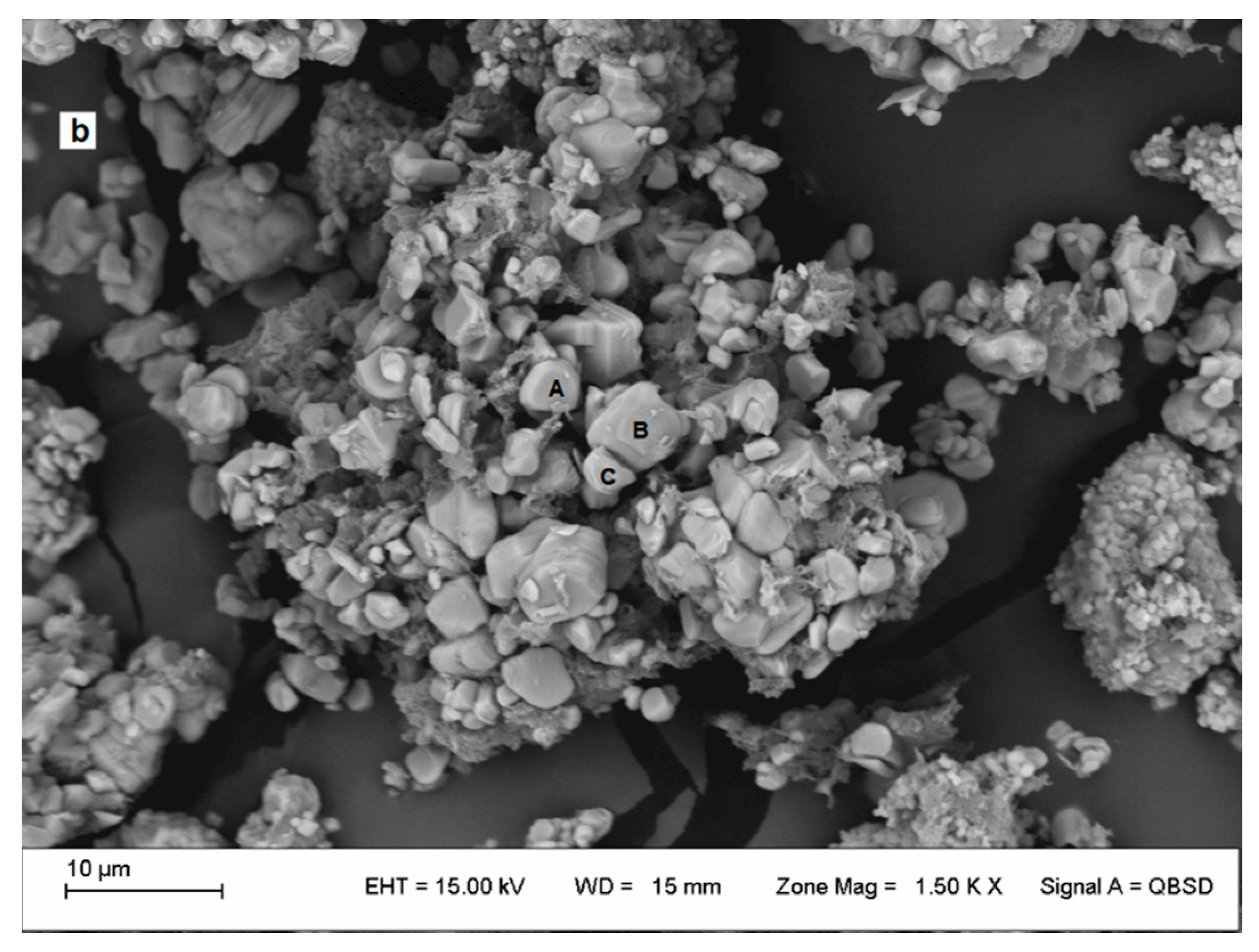
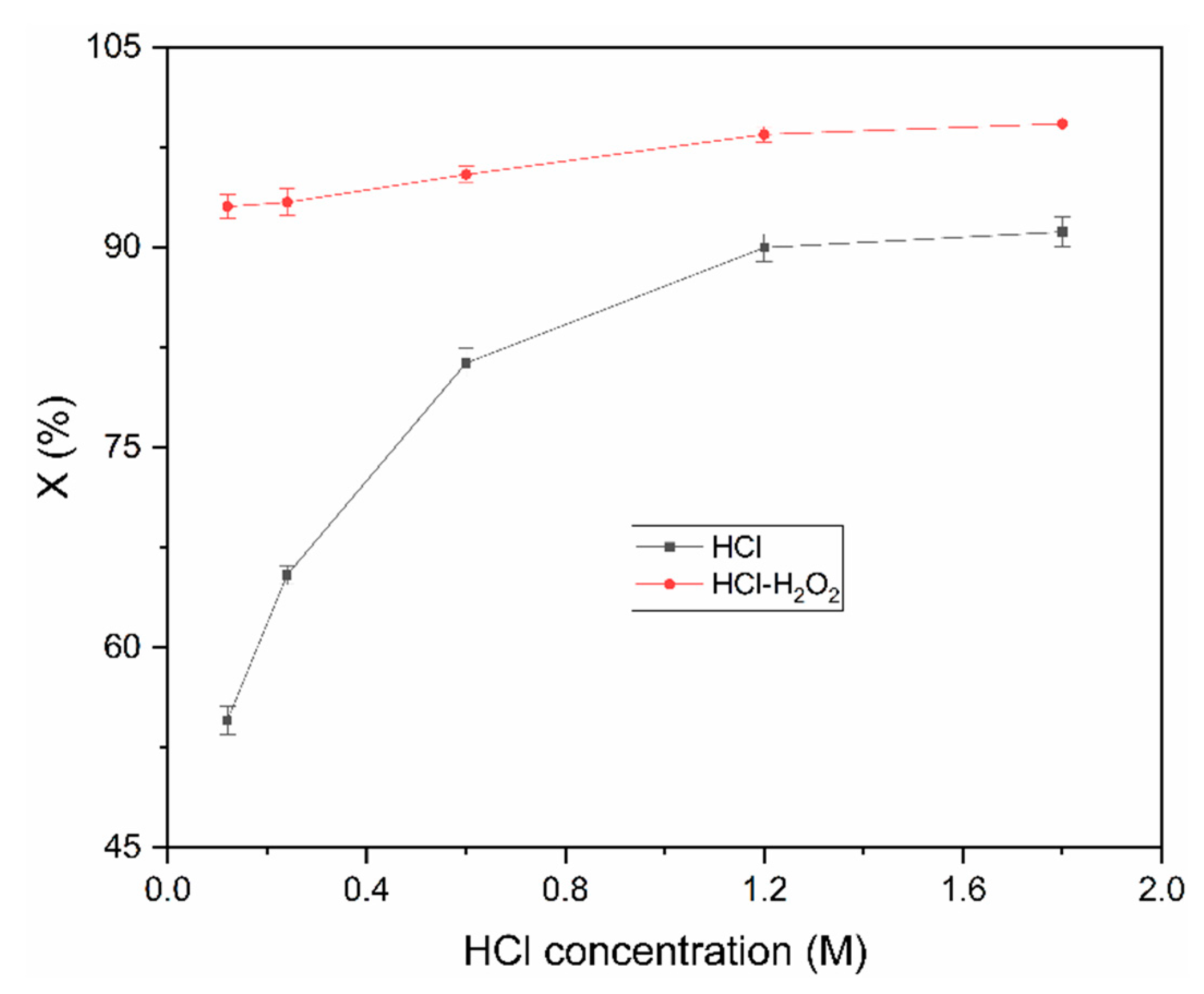
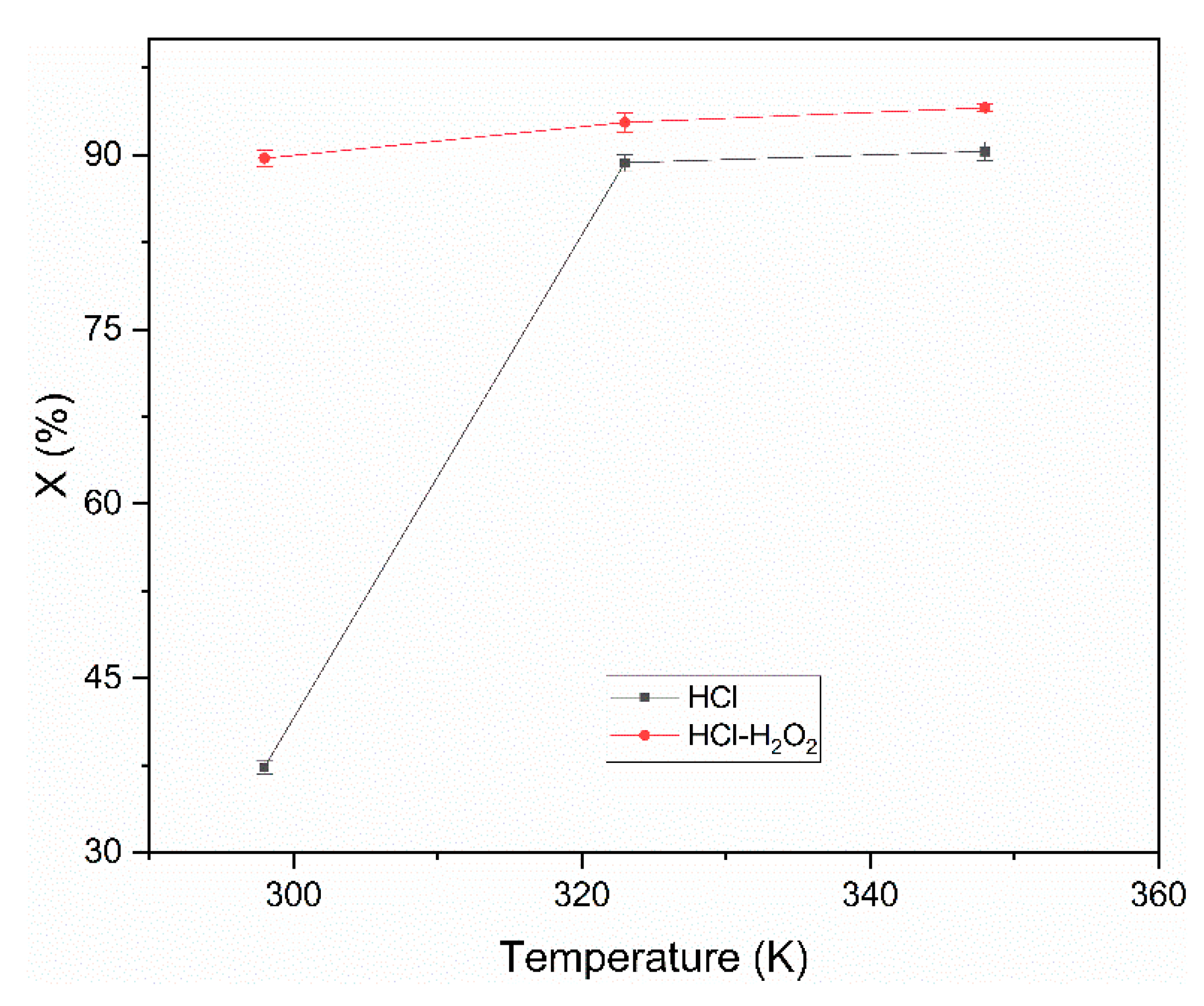
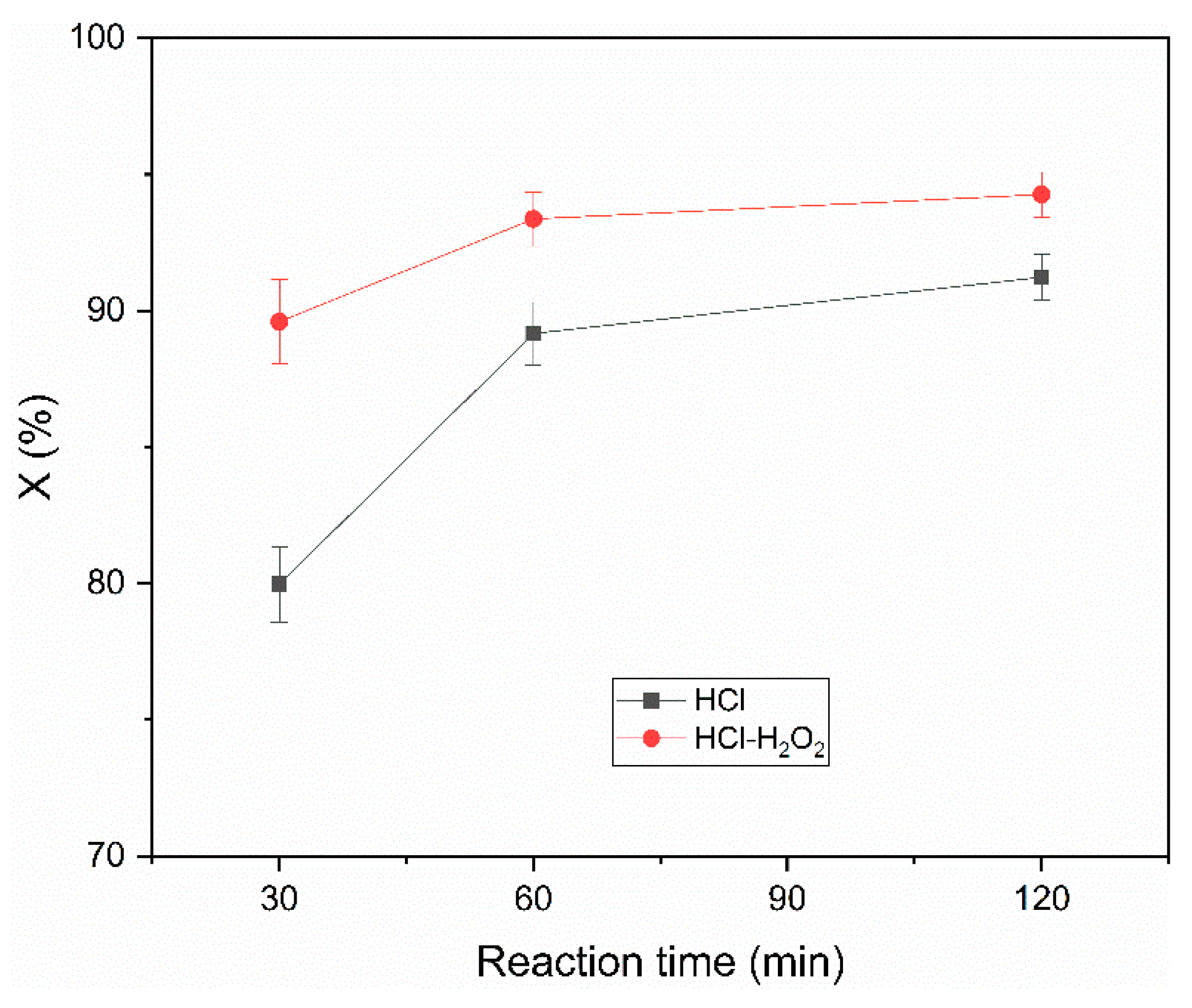
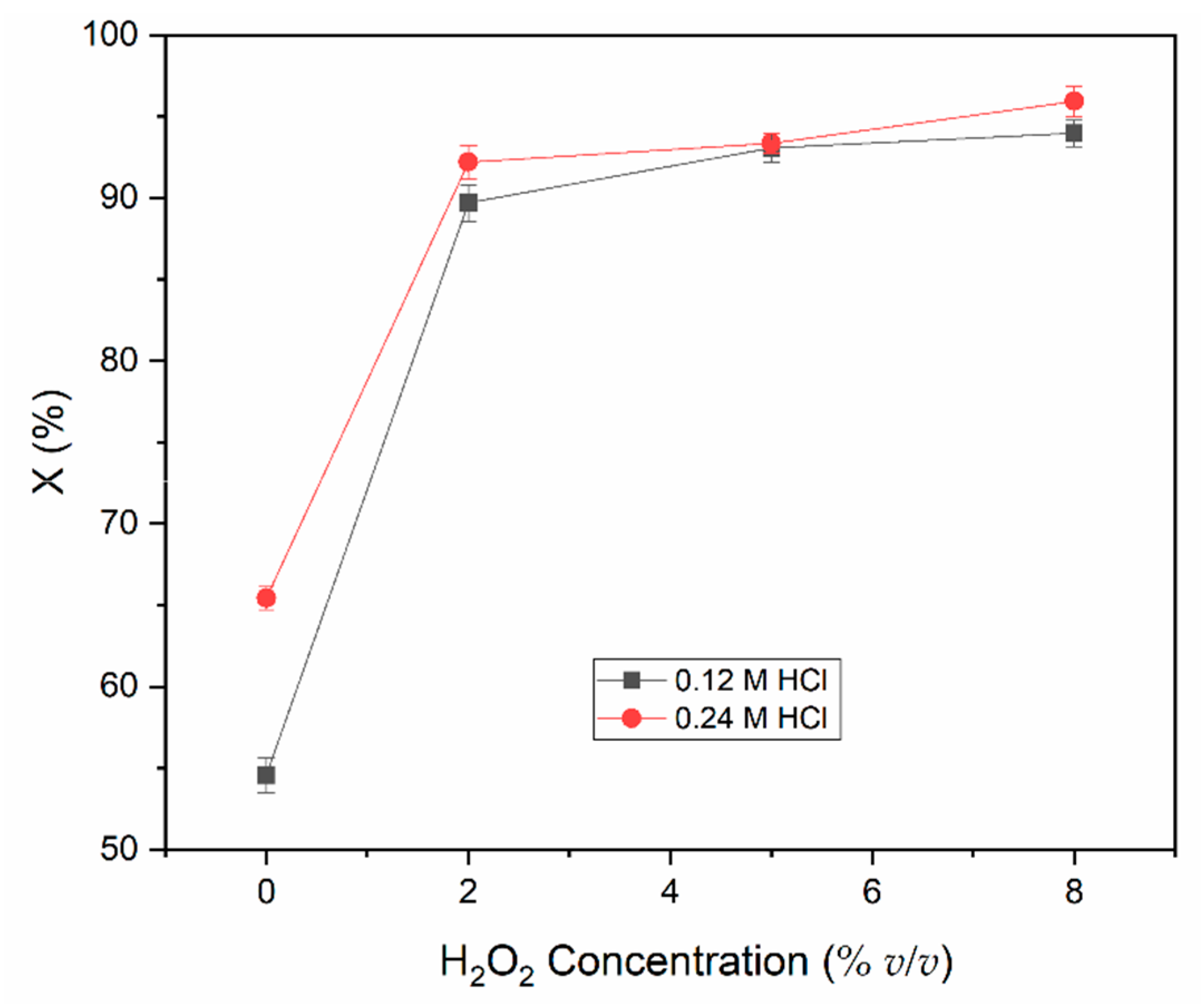
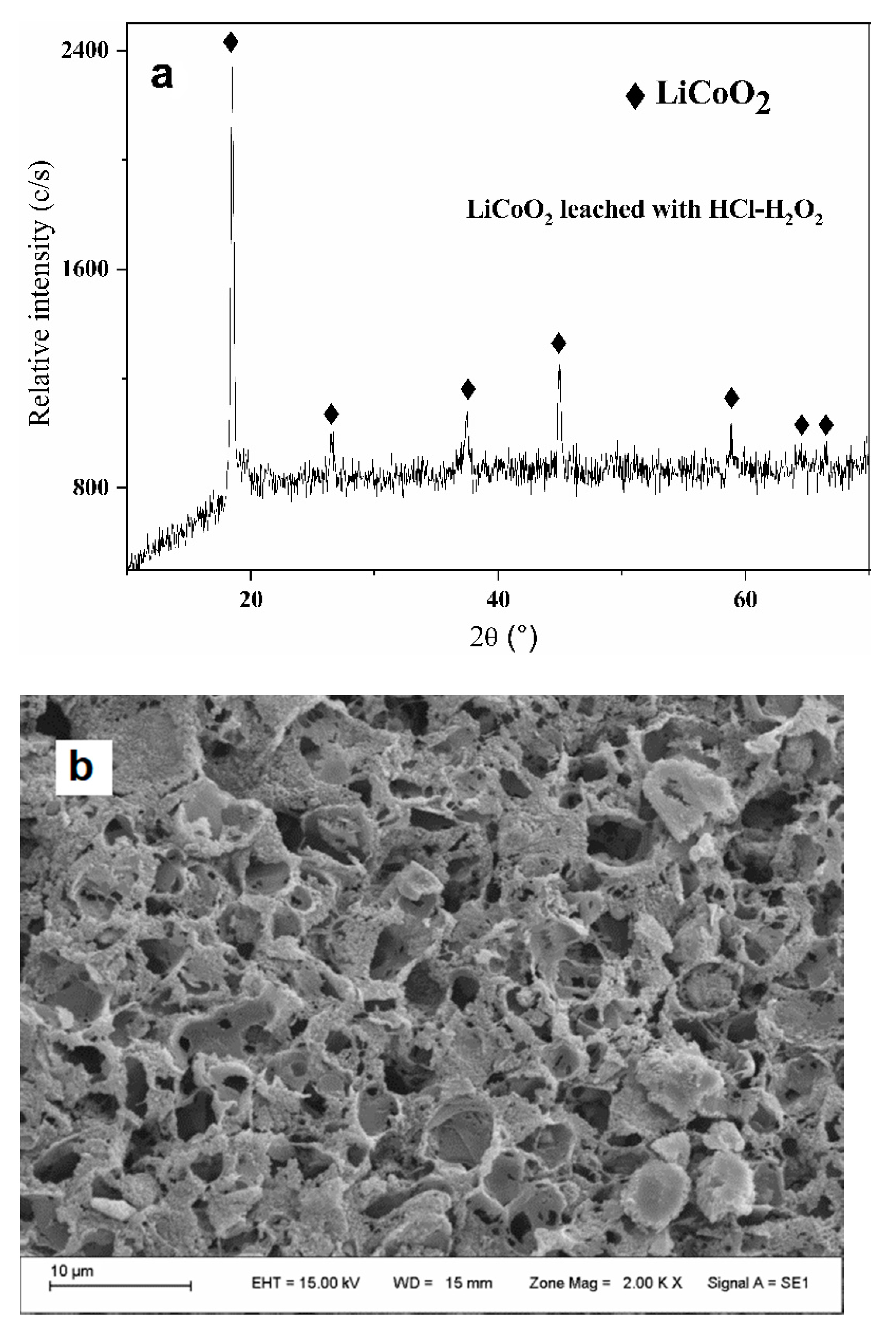
| Particle | O (%) | Co (%) | Ni (%) | Mn (%) |
|---|---|---|---|---|
| A | 29.41 | 70.42 | - | 0.17 |
| B | 14.90 | 84.47 | 0.63 | - |
| C | 23.87 | 76.13 | - | - |
Publisher’s Note: MDPI stays neutral with regard to jurisdictional claims in published maps and institutional affiliations. |
© 2022 by the authors. Licensee MDPI, Basel, Switzerland. This article is an open access article distributed under the terms and conditions of the Creative Commons Attribution (CC BY) license (https://creativecommons.org/licenses/by/4.0/).
Share and Cite
Drajlin, D.S.; Suarez, D.S.; Toro, N.; Gálvez, E.D.; Pinna, E.G.; Rodriguez, M.H. Comparative Study of the Dissolution of LCO in HCl Medium with and without H2O2. Metals 2022, 12, 727. https://doi.org/10.3390/met12050727
Drajlin DS, Suarez DS, Toro N, Gálvez ED, Pinna EG, Rodriguez MH. Comparative Study of the Dissolution of LCO in HCl Medium with and without H2O2. Metals. 2022; 12(5):727. https://doi.org/10.3390/met12050727
Chicago/Turabian StyleDrajlin, D. Sebastián, Daniela S. Suarez, Norman Toro, Edelmira D. Gálvez, Eliana G. Pinna, and Mario H. Rodriguez. 2022. "Comparative Study of the Dissolution of LCO in HCl Medium with and without H2O2" Metals 12, no. 5: 727. https://doi.org/10.3390/met12050727
APA StyleDrajlin, D. S., Suarez, D. S., Toro, N., Gálvez, E. D., Pinna, E. G., & Rodriguez, M. H. (2022). Comparative Study of the Dissolution of LCO in HCl Medium with and without H2O2. Metals, 12(5), 727. https://doi.org/10.3390/met12050727








